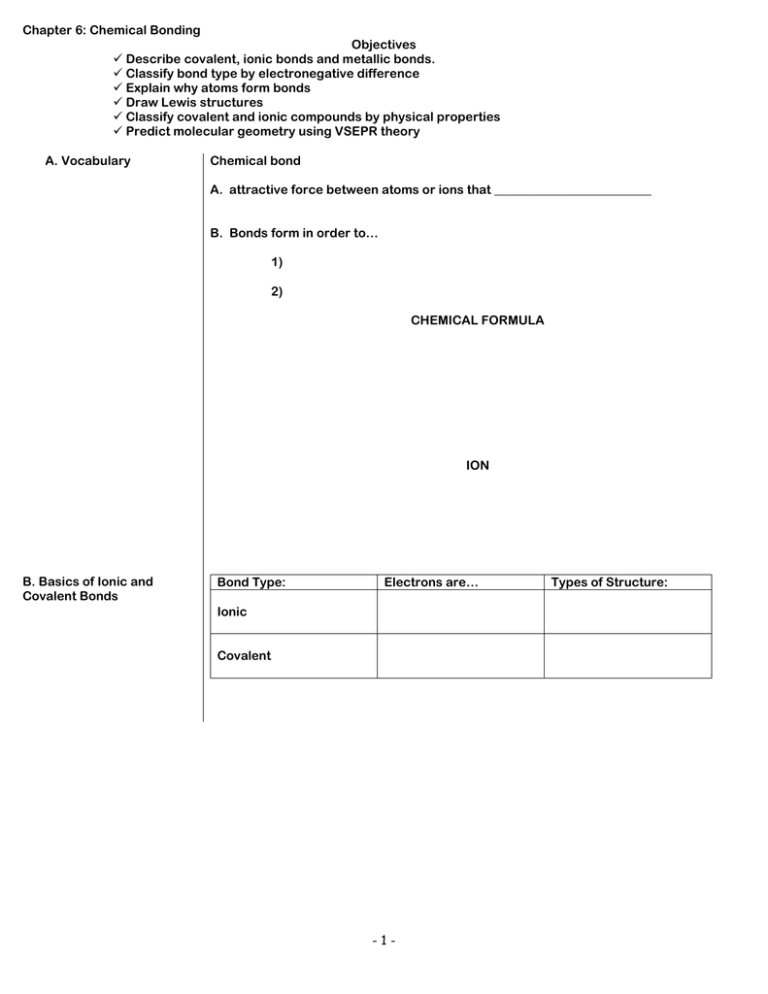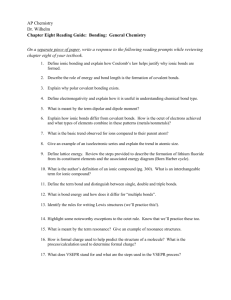Chapter 06
advertisement

Chapter 6: Chemical Bonding Objectives Describe covalent, ionic bonds and metallic bonds. Classify bond type by electronegative difference Explain why atoms form bonds Draw Lewis structures Classify covalent and ionic compounds by physical properties Predict molecular geometry using VSEPR theory A. Vocabulary Chemical bond A. attractive force between atoms or ions that _________________________ B. Bonds form in order to… 1) 2) CHEMICAL FORMULA ION B. Basics of Ionic and Covalent Bonds Bond Type: Electrons are… Ionic Covalent -1- Types of Structure: C. Bond Polarity Electronegativity 1) 2) In covalent molecules: a) 3) 4) Nonpolar Covalent Bond 1. 2. 3. Polar Covalent Bond 1. 2. 3. -2- % Ionic Character Difference in electronegativity b) Examples Elements Electronegative difference Bond Type More negative atom H&S Cs & S S & Cl C&H O&O D. Bond Formation E. Lewis Structures - Electron dot notation - Electron dot examples Na Mg Al -3- C N O F Ne Octet Rule - Octet Rule - Structural formulas and Lewis Structures What is the difference? For covalent bonds: Element Hydrogen Group 1* Valence e- Bonds Group 2* Group (boron) Carbon Nitrogen Oxygen Halogens * Note that Group 1 and 2 metals usually form Ionic bonds. -4- Octet Rule E. Lewis Structures Examples Covalent – Ionic – NaCl = CH4 = CaCl2 = C2H4 = F2 = N2 = H2O = CH2O2 = F. Bond Traits: IONIC COVALENT METALLIC Bond Formation Type of Structure Physical State Melting Point Solubility in Water Electrical Conductivity Other properties G. VSEPR Theory ________________________ orient themselves in order to minimize repulsive forces. Types of Electron Pairs _____________________________ - Form bonds _____________________________ - nonbonding electrons. -5- Bonding chart with Examples: H. Common VSEPR Shapes Formula Bonded e- Lone pairs -6- 2D drawing Shape name I. Metallic Bonding Malleability – Ductility – Explain electron sea J. Intermolecular Forces ____________________________ - polar covalent molecules where there is an asymmetrical electron density across the entire molecule (not just in the bonds) ________________________________________ - occur when dipoles line up and attract each other K. Hydrogen Bonds L. London dispersion Forces _____________________________ - super dipole-dipole interactions between δ+ on hydrogen and δ- charges on other parts of a molecule ________________________________ - are the attractive forces between temporary dipoles created by random motion of electrons The more e- involved, the _____________________ the London dispersion forces -7-






